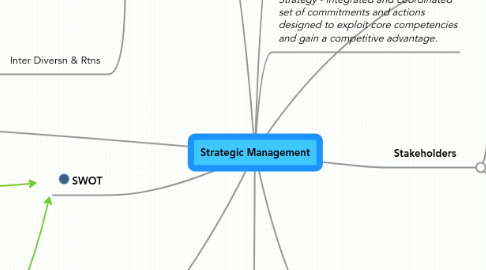
1. Other Inputs
1.1. Goals
1.2. Strategic Mission
1.2.1. Vision - what the org wants to be
1.2.2. Mission - what we do
1.2.3. Values
1.3. Strategic Intent
1.3.1. Leveraging Res, Capabils & c/competencies to achieve goals in comp. environment
1.3.2. Have the mob with you
2. Inputs
2.1. Ext Env
2.1.1. General
2.1.1.1. PEST
2.1.2. Industry
2.1.2.1. TE
2.1.2.1.1. Economies of Scale
2.1.2.1.2. Prod Differentiation
2.1.2.1.3. Capital
2.1.2.1.4. Switching costs
2.1.2.1.5. Access to distribution
2.1.2.1.6. New node
2.1.2.2. TSub
2.1.2.3. PSup
2.1.2.3.1. Choice
2.1.2.3.2. High Switching Costs
2.1.2.3.3. Importance of Goods
2.1.2.3.4. Forward integration
2.1.2.4. PBuy
2.1.2.4.1. Switching cost
2.1.2.4.2. Purchase a large portion
2.1.2.4.3. Differentiated products
2.1.2.5. IRiv
2.1.2.5.1. Numerous or equal competitors
2.1.2.5.2. Slow industry growth
2.1.2.5.3. High fixed/storage costs
2.1.2.5.4. Lack differentiation/low switching costs
2.1.2.5.5. High strategic stakes
2.1.2.6. Govt
2.1.2.7. Complementors
2.1.3. Competitor (org & competitors)
2.1.3.1. Future objectives
2.1.3.2. Current strategy
2.1.3.3. Assumptions
2.1.3.4. Capabilities
2.1.4. Ext Enviro Anal Process
2.1.4.1. scan, mon, f'cast, assess
2.2. Int Env
2.2.1. Resources
2.2.1.1. Capabilities
2.2.1.1.1. Core Competencies
2.2.1.1.2. Value Chain
2.2.2. SCA
3. SWOT
4. Global
4.1. Cost vs local response
4.1.1. International
4.1.2. Transnational
4.1.2.1. matrix & hybrid struc
4.1.3. Multi-Domestic
4.1.3.1. dec functional struc
4.1.4. Globalisation
4.2. Understand Nation C/A
4.2.1. Rivalry
4.2.2. Factor endowments
4.2.3. Local Demand
4.2.4. Competitiveness of related products
4.3. Entry mode
4.3.1. Export
4.3.2. License
4.3.3. Franchise
4.3.4. Joint venture
4.3.5. Strategic Alliance
4.4. Inter Diversn & Rtns
4.4.1. broad divn typ = hgher rtns
4.4.2. potential ecos of scale
4.4.3. incr assess flex labour mkts & size
4.4.4. location adv
4.4.5. glob netwks incr
5. Entrepreneurship
5.1. corporate
5.2. Innovation
5.2.1. Invention
5.2.2. Innovation
5.2.2.1. internal
5.2.2.1.1. 2 types: autonomous or induced strategic behaviours
5.2.2.1.2. internal corp venturing
5.2.2.2. incremental
5.2.2.3. radical
5.2.2.4. cooperative strategies
5.2.2.5. Acquisition
5.2.3. Imitation
5.3. International
5.4. strategic
5.4.1. size/age of org can impact its success based on willingness to take risks
6. Strategy - integrated and coordinated set of commitments and actions designed to exploit core competencies and gain a competitive advantage.
7. Strategic Group
7.1. implicatns: rivalry cn be intense, the strength of 5 forces differs across groups, changing grps can be difficult
8. Formulation
8.1. CLS: diversification (3 levels) & growth
8.1.1. Reasons for diversification
8.1.1.1. Value creating
8.1.1.2. Value neutral
8.1.1.3. Value reducing
8.1.2. Single biz = 95%rev from core biz
8.1.3. 1. Dominant biz = 70-95% from core
8.1.4. 'Related diversification' (dev & exploit eco of scope)
8.1.4.1. dom biz = less 70% rev
8.1.5. 2. 'Related constrained' - share resources
8.1.5.1. mod-high less than 70%
8.1.5.1.1. central struct
8.1.6. Related linked
8.1.6.1. share fewer resources and more transferring of knowledge
8.1.6.2. less 70% rev & limited links bn bizs
8.1.6.3. seperate profit centres
8.1.7. 3. Unrelated
8.1.7.1. less than 70% & no common links
8.1.7.2. Reduce risk
8.1.7.3. Harder to manage
8.1.7.4. perform is based on fin criteria, very decentralised
8.2. BLS (prod mkt)
8.2.1. Id customers: who what how
8.2.2. 1 Cost Lship
8.2.2.1. central CL functional structure
8.2.3. 2. Differentn
8.2.3.1. Suits smaller firms
8.2.3.1.1. decentr function decision mkg
8.2.4. 3. Focussed
8.2.4.1. comp segmt: buyer grp, prod line, geogrpahic
8.3. Functional
8.3.1. Gen Blg Blocks CA
8.3.1.1. Sup efficiency
8.3.1.1.1. =out/inpu, eco of scale, learng effects, prod, material mgt, Mktg, IT, HR, ,R&D, HR, Infra,
8.3.1.2. Sup innovation
8.3.1.2.1. bld skills & proc incl xfunctional intergration high fail rate
8.3.1.3. Sup quality
8.3.1.3.1. TQM
8.3.1.4. Sup cust responsiveness
8.3.1.4.1. focus on cust, id bettr ways to sat needs
8.3.1.4.2. what when w/out comp l/term prfty, & deliv a comb of all above
9. Implementation
9.1. Match with Strategy!
9.1.1. A checklist incl changes in staff, style, systems, structure, shared values, and skills
9.2. Structure
9.2.1. Horizontal/Vertical
9.2.2. Good Design
9.2.2.1. Lower cost
9.2.2.2. Higher Prices
9.2.3. Tall/Flat
9.2.4. Centralised/Decentralised
9.2.5. Matrix/Product Team/Geographic
9.3. Controls
9.3.1. Balanced Scorecard
9.3.1.1. Financial
9.3.1.2. Customer
9.3.1.3. People Learning & Growth
9.3.1.4. Internal processes
9.3.2. Strategic
9.3.2.1. subj criteria
9.3.3. Financial
9.3.3.1. obj criteria
10. Stakeholders
10.1. Identify s/h + interests
10.2. 3 Types
10.2.1. Capital
10.2.2. Product
10.2.3. Organisation
